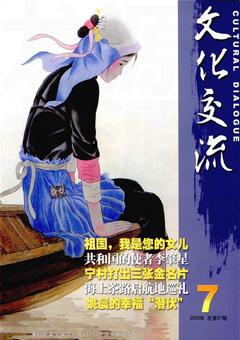Ding Cong and His Famous Cartoon
By Mo Zhu

93-year-old Ding Cong passed away on May 26th, 2009. His wife composed a letter and put it on his chest as a way to say farewell. Ding Cong once concluded that he felt happy he did one thing right: he was able to make cartoons all his life. His cartoon career spanned more than seven decades. All his life as a cartoonist he used one name: Little Ding. The name describes both the man and his cartoons: humor, wisdom, outspokenness, fun, and grace. Ding Cong explained another meaning of his art name: he had only middle school education; he had never been a leader; he always regarded himself as an ordinary man.
Ding Cong was born in Shanghai in 1916. His father Ding Song was a cartoonist. The salon at his house was frequented by celebrated film stars and composers and painters. The senior preferred a different path for his son, but the junior had a passion for the art of cartoon. To distinguish himself from his father, Dong Cong singed Little Ding to his works.
From 1945 to 1947, he published a series of cartoons in Shanghai in favor of democracy. The cartoons condemned the anti-democratic measures of the national government. After the founding of New China, he once served as a vice director of Peoples Pictorial. Over the last 30 years, he published nearly 40 collections of his cartoons and illustrations. The satire in his cartoons was a highlight constant in Reading, an elite monthly dedicated to literary reviews and criticism. He is fondly remembered for his thousands of cartoons directed at the absurdities in everyday life and politics. They embody his conscience and his sense of responsibility.
In the memories of his friends, Ding was young forever. His youthful energy and his black hair were more than his trademark. They were a constant topic among his friends. At a gathering, the 88-year-old Ding responded to a discussion of his youthfulness, saying that he had to feel old now. He explained that nobody had offered a seat to him in bus just two years before, but now people did. Asked about his secret for keeping the youthfulness, his answer was direct and bizarre and merriment-inducing: “No fitness workout! No fruit! No vegetables! Be a meat eater!” He had a huge belly.
Ding Cong humorously attributed his legendary longevity to his obsession with meat eating. His addiction to meat eating was widely known. He painted a cartoon for Louwailou Restaurant in Hangzhou, trying to offer a solution to a debate he created for himself. Zheng Banqiao (1693-1765), a poet and painter of the Qing Dynasty (1644-1911), had such an obsession with bamboo that he deliberately created a virtual dilemma to show his preference: if he would have to choose between meat and bamboo, he would have bamboo. Ding Cong opposed Zhengs preference and choice vehemently. He preferred meat to bamboo. Su Dongpo, a great poet of the Song Dynasty (960-1127), is believed to have been the first man who put himself in such a bind about bamboo and meat. Su said in a poem to the extent that one becomes thin without eating meat and one becomes vulgar without having bamboo in his life and that, to avoid becoming thin and vulgar, he would prefer a dish of bamboo shoots and pork.
In celebrating the 150th anniversary of the founding of Louwailou restaurant in 1998, Ding created a cartoon to present the funny dilemma and his solution. It shows Zheng Banqiao and Su Dongpo, with chopsticks in their hands, looking at a delicious bowl of pork stewed with bamboo shoots served by a waitress of Louwailou.
The Louwailou Restaurant in Beijing invited Ding to a feast of pork and bamboo shoots one winter evening in 2000. Two chief executives of the restaurant came all the way from Hangzhou to Beijing in order to attend the banquet. □

